A recent article in The Guardian reports that most Queensland churchgoers support voluntary assisted dying (VAD), citing a recent YouGov poll commissioned by the Clem Jones Trust.
In fact, attitudes in support of VAD have been strengthening across Australia for many years, and the last few are no exception. In this analysis I explain, using impeccable Australian Election Study (AES) data gathered by a specialist team at Australian National University.
Each federal election, the AES gathers extensive demographic and attitudinal data from a substantial sample of Australians. That means we have comparable snapshots from each election in recent times, including 2019, 2016, 2013, 2010 and 2007 (though attitudes toward VAD have been asked only since 2016).
First up, given the well-documented strong connection between higher religiosity and less favourable attitudes towards VAD, let’s take a quick look at Australia’s changing religious landscape.
Abandoning religion: from trickle to torrent
Since federation, periodic census data collected by the Australian Bureau of Statistics (ABS) confirms a long-term decline in religious affiliation (Figure 1).
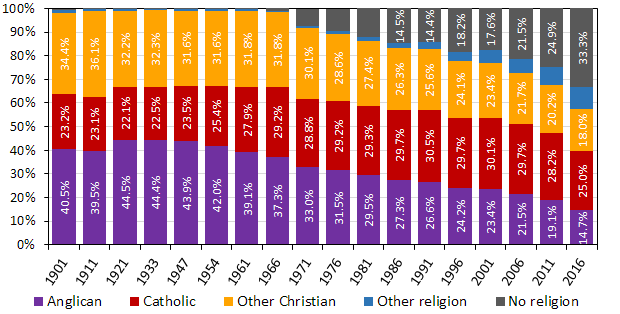
Even this data generally overstates actual religious affiliation, compared with repeated good-quality polls. Census data has pegged religious affiliation typically 4-8% higher than do most polls.
That’s because until the most recent census (2016), collections had primarily or exclusively used a single, massive booklet for household completion. Mr Jones was unlikely to upset Mrs Jones by ticking the “No religion” box when he thinks she’s sure the family is Anglican, and she can see his answers. In contrast, relatives are not looking over the shoulder of an opinion poll respondent, which allows them to be more frank.
Additionally, a formal booklet is more likely to prompt respondents to answer in terms of historical household identity (a lagging indicator), while ad hoc surveys are more likely to prompt answers in terms of recent, pragmatic attitudes and practices (current indicator).
Abandoning religious identity
AES data clearly shows that for major denominations, Australians are leaving institutionalised religion in droves (Figure 2).

Over just 12 years Catholic affiliation has dropped from 28% to 21% (a drop of 26% of its flock); Anglican from 21% to 15% (-29%); and Uniting/Methodist from 8% to 4% (-52%). In total, minor Christian denominations have remained around the same, while non-Christian denominations have experienced a small increase, mostly from immigration.
But by far the most dramatic change over the 12 years is that No Religion has soared from 26% to 41% of the population, an increase of 61%. The largest increase was between 2016 and 2019, most likely a result of Australians’ dismay at the 2017 reports of the royal commission into institutional responses to the sexual abuse of children. It found that most offences occurred in religious institutions, more than half of them in the Catholic Church alone.
Abandoning religious practice
Not only have Australians been abandoning religious identity, but for the most part increasingly abandoning religious practice (Figure 3).
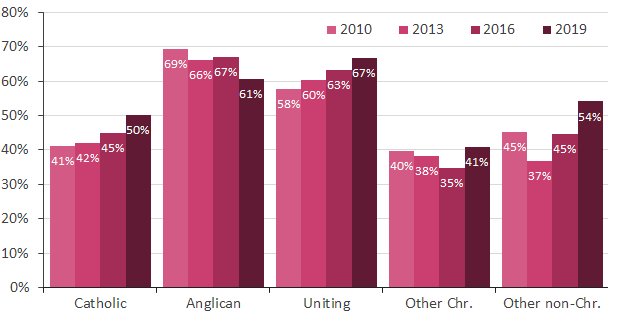
At the same time as many Australians have abandoned religious identity, those still identifying with Catholic, Uniting, and non-Christians faiths are attending services less than before.
Overall, service attendance has remained about the same amongst minor Christian denominations, and there has been an increase amongst Anglicans (actually because far more Notionals — people who identify with a denomination but never attend religious services — have “left” the Anglican church).
Indeed, in 2019, fewer than half of Australians (47%) ever attend religious services, just a third (32%) attend more often than once in a blue moon, and a mere 16% are consistent attenders.
Clerics might still be talking, but fewer Australians than ever want to listen.
Abandonment to continue
Australians will continue to abandon religion given that most younger Australians reject religion at the same time that older, more religious Australians pass away (Figure 4).
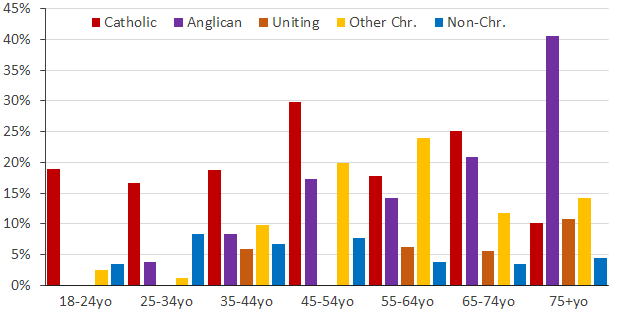
This picture is even more dire for clerics than it was just three years earlier in 2016 (Figure 5).
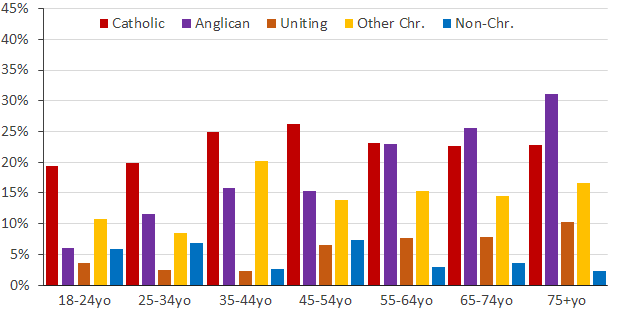
Over the next 25 years, the Catholic church and minor Christian denominations will struggle, while the Anglican and Uniting churches will almost cease to exist if current trends continue.
An integrated measure of religion
For further analysis, we’ll use the Australian Religious Identity 6-Factor (ARI6) model. It segments on the combined basis of religious attitudes and behaviour across a spectrum from Rejecters to Devouts.
Unsurprisingly over the past decade, Devouts have remained firmly entrenched in their faith (Figure 6), while there has been a small downward trend amongst Regulars.
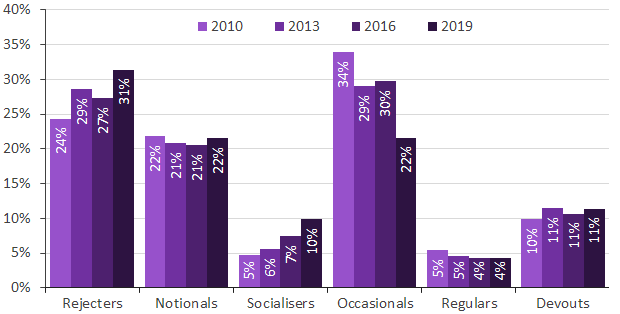
Most of the abandonment of religion in recent years has been amongst Occasionals, those who identify with a religious denomination but rarely attend services. This begs the question as to whether clerics were right to assume that they spoke for many in their flocks in the first place.
Attitudes toward VAD — Overall
Between 2016 and 2019 there was a small but statistically non-significant increase in total support for VAD, while there was no change in total opposition (Figure 7).

What is readily apparent, though, is a substantial increase in the number of Australians strongly in support of VAD (from 43% to 53%), while total opposition has remained tiny at fewer than one in ten Australians (9%).
Attitudes toward VAD — Religious affiliation
Amongst Australians who still count themselves as religiously affiliated in 2019, a majority of all religions except minor Christian denominations clearly favour VAD (Figure 8), including three quarters (74%) of Catholics, four in five Anglicans (78%) and Uniting/Methodists (81%), and almost all non-Christian religious (96%) and non-religious (92%).
Even amongst the minor Christian denominations with nearly half (49%) in support, just one in five (20%) were opposed to VAD, the rest being neutral.
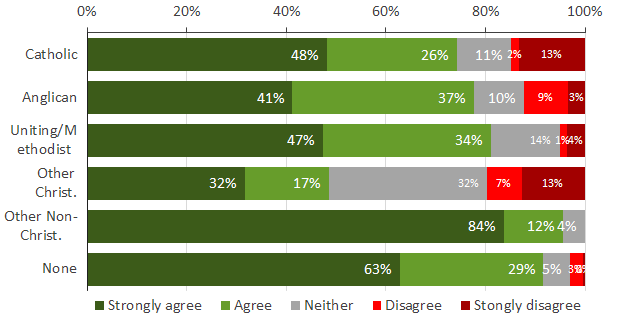
Strong support amongst Catholics increased massively from 36% in 2016 to 48% (close to half in strong support) in 2019, highlighting the irony of Catholic clergy continuing to actively oppose VAD law reform.
Given the tiny minorities opposed across the religious spectrum, those clerics who continue to vocally oppose the legalisation of VAD — including some employing serious misinformation — in no way are speaking for the majority of their flocks.
Attitudes toward VAD — Religiosity
Unsurprisingly, given the vast body of existing scholarly research evidence, opposition to VAD is largely religious (Figure 9).
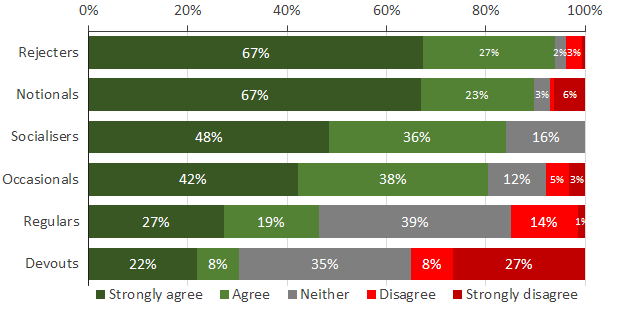
Nearly half of all opposition to VAD (44%) is of Devouts, with an additional quarter (26%) amongst Regulars and Occasionals, and a smaller proportion (17%) from Notionals.
Tellingly, even amongst the most religious, opposition to VAD has dropped significantly in just three years since 2016 (Figure 10). Opposition to VAD amongst Devouts dropped from nearly half (46%) to just over a third (35%), and amongst Regulars from 25% to just 15%.
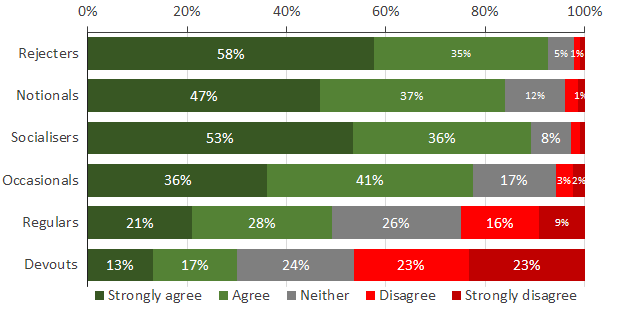
For 2019, proportions of the most opposed religious segment, Devouts, are almost evenly split amongst supporters, neutrals and opposers.
Amongst the next most religious, Regulars, supporters outnumber opponents by three to one, and in all the other segments supporters outnumber opponents by more than ten to one.
The evidence is clear: even amongst the most religious Australians, opposition to VAD is melting away.
The lowdown for politicians
What does this mean for legislators, who the community is asking to legalise VAD with responsible safeguards? Figure 11 shows VAD attitudes of Australians by the political party they identify with.
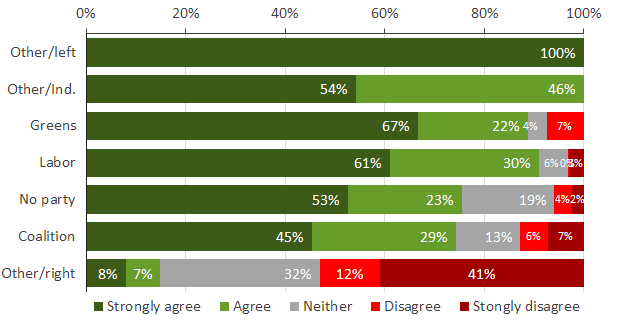
It’s obvious why VAD Bills have been sponsored by Greens members and/or facilitated by Labor governments.
In contrast, Australian Coalition parliamentary parties (with notable exceptions of a handful of Coalition members) have steadfastly obstructed consideration and passage of VAD Bills. This is not because the party machinery is representing the broader Coalition voter, whose overall support stands at 74% versus a tiny 13% opposed. Rather, it’s because of the (widely reported) takeover of the party machinery by the religious right.
The natural home of VAD opponents is minor right parties, comprising overall a slight majority (53%) opposed to VAD. [Addendum: those identifying with minor right parties comprise just 3.1% of the adult Australian population.]
Given that minor right party voters are most likely to give their major party preference flow to the Coalition, the real concern for Coalition election strategists is to minimise first preferences going to a minor right party in the one or two electorates (if any) in which such a minor party win might even be on the cards.
The lowdown for election candidates
It’s been a firm belief among the political class for a long time that candidates openly supporting VAD would be punished at the polls on election day, with little to no downside for candidates opposed to VAD. That, however, is fake news.
A 2012 Newspoll survey asked voters if, all other things being equal, they would change their vote if their otherwise preferred election candidate’s stance was the opposite of their own (support vs opposition). (Full disclosure: as CEO of YourLastRight.com I commissioned the survey.)
VAD-supporting voters stated they would punish their preferred candidate (opposing VAD) at three times the net rate that VAD-opposing voters would punish a supporting candidate. I’ve subsequently published various other observations that are consistent with this finding.
Now that strong support for VAD amongst the Australian public is significantly higher than it was in 2016 (let alone 2012), it would be foolhardy for any supportive politician to hide their light under a bushel, or for an opposed candidate to effectively thumb their nose at the majority of voters.
I’m reminded of a favourite remark of Sir Humphrey Appleby (Nigel Hawthorn) in the 1980s British political comedy series Yes Minister, who would gently point out his Minister’s policy folly (Jim Hacker played by Paul Eddington) with the light remark, “that would be very courageous, Minister!”
It’s now a very courageous candidate indeed who believes their personal opposition to VAD ought to trump the support of the vast majority of their constituency. And, given the ongoing abandonment of religion in Australia, such candidates will soon find themselves on the wrong side of history.
The lowdown for campaigners and voters
Given that most Australians — increasingly including the religious — are in favour of responsible VAD law reform, and with a growing proportion strongly in support, it’s more important than ever to determine election candidates’ real attitudes toward VAD.
Some candidates provide prompt and candid responses to help voters decide. But many candidates obfuscate, either failing to respond at all or responding with non-answers such as they haven’t seen specific legislation yet so cannot answer, or cynically stating only the obvious such as “opinions vary” and it can be “an emotive issue”.
The key action with obfuscators is to get a real answer to the question “could there be any version of a VAD Bill that could enjoy your support?” And assume those who still obfuscate would have said “no”, had they been candid.
 | Neil Francis is past president of the World Federation of Right To Die Societies, former chair of YourLastRight.com, a national alliance of Australian assisted dying societies, and past president of Dying With Dignity Victoria. He maintains arguably the world's largest special-purpose database of peer-reviewed professional journal papers traversing all aspects of assisted dying. |
|---|
Reprinted with permission from the author. Read the original at Dying for Choice here.

